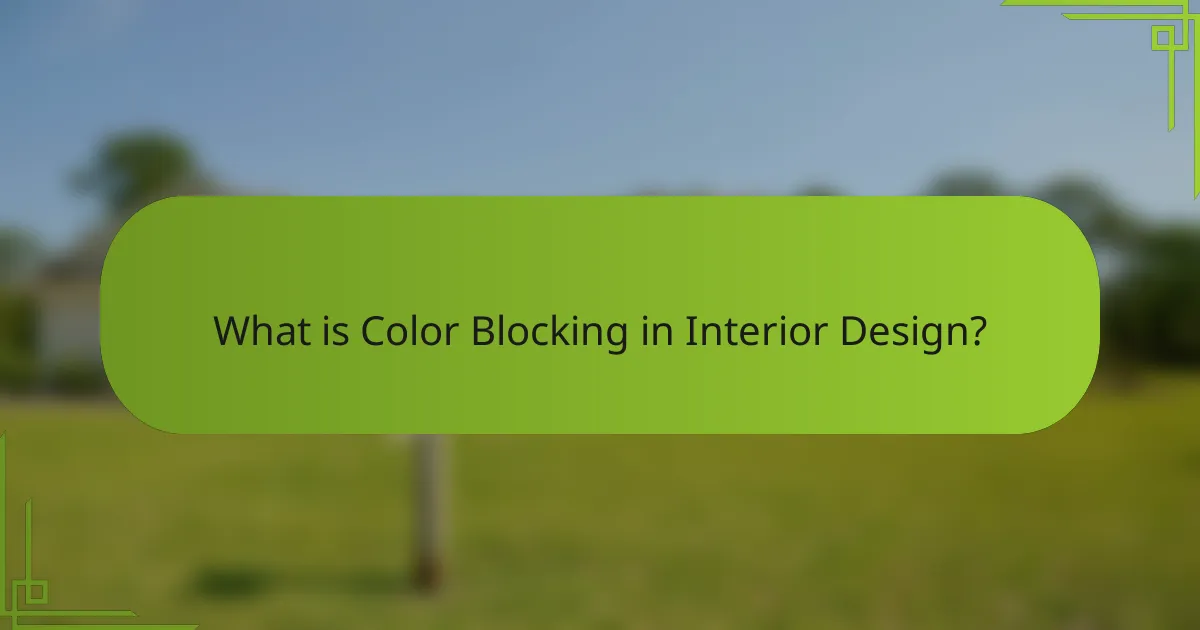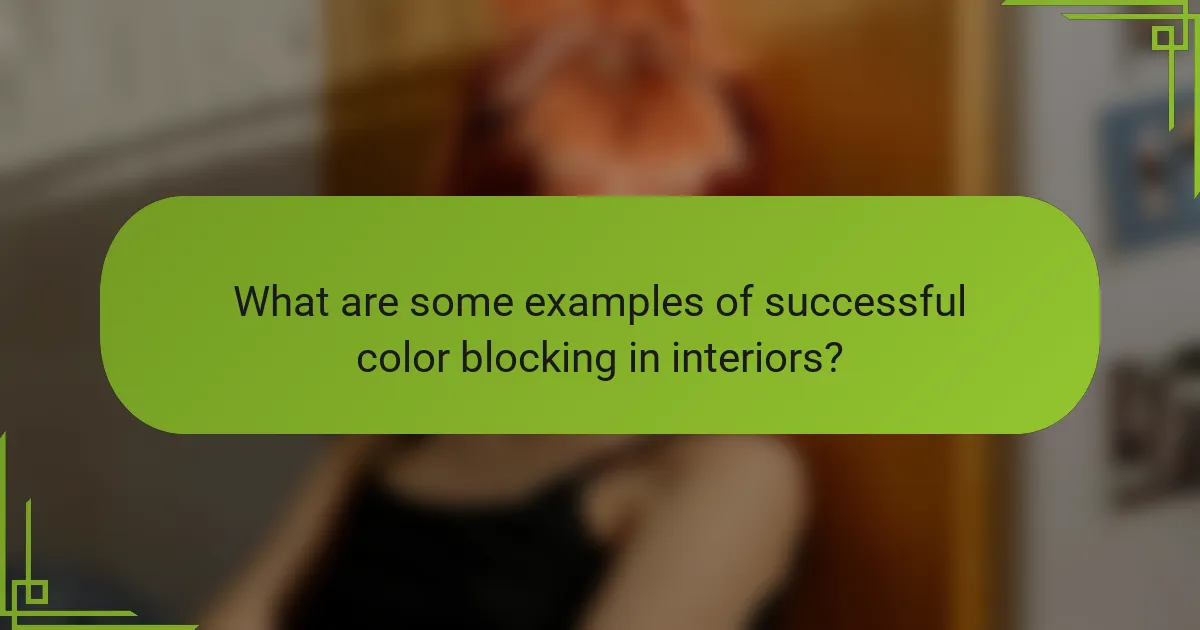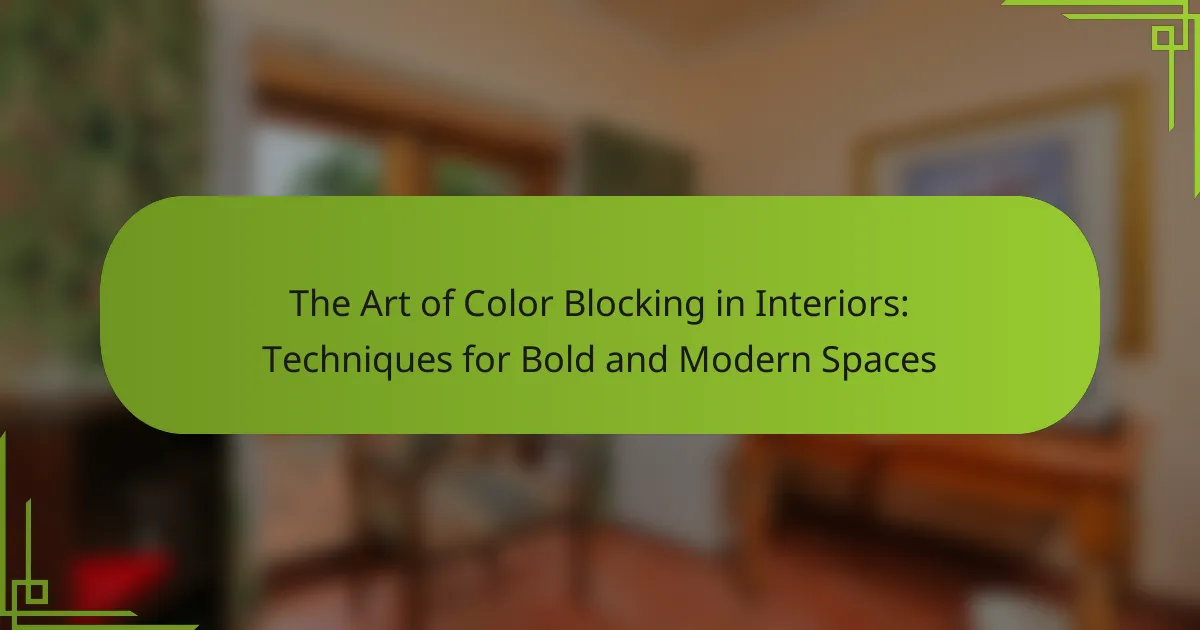
What is Color Blocking in Interior Design?
Color blocking in interior design is a technique that involves using contrasting colors in bold, geometric patterns. This method creates visual interest and dynamic spaces. Designers often apply color blocking to walls, furniture, and accessories. It can enhance the mood of a room and define areas within open spaces. The technique draws from art movements that emphasize color as a focal point. Popular color combinations include bright hues paired with neutral tones. Studies show that color can influence emotions and perceptions of space. Color blocking can make smaller rooms appear larger and more inviting.
How did the concept of color blocking evolve in interior spaces?
Color blocking in interior spaces evolved from early 20th-century art movements. Initially influenced by modernism, artists like Piet Mondrian used bold colors and geometric shapes. This artistic approach transitioned into interior design in the 1960s and 1970s. Designers began applying color blocking to walls, furniture, and decor, creating striking contrasts. The trend saw a resurgence in the 2010s, driven by a desire for personalization and bold aesthetics. Today, color blocking is embraced for its ability to define spaces and create visual interest. It allows for creative expression while enhancing the overall ambiance of interiors.
What historical movements influenced the rise of color blocking?
The rise of color blocking was influenced by several historical movements. The Bauhaus movement emphasized simplicity and geometric forms, laying the groundwork for bold color combinations. Modernism, which followed, celebrated innovative design and the use of color to create visual interest. The Pop Art movement further popularized vibrant color palettes, integrating everyday objects with striking color contrasts. Additionally, the postmodern design movement embraced eclectic styles, allowing for more daring color applications. Each of these movements contributed to the acceptance and popularity of color blocking in interior design.
How does color blocking differ from other design techniques?
Color blocking differs from other design techniques by using large, solid blocks of color to create visual impact. This approach contrasts with techniques that utilize patterns or gradients. While many design methods focus on subtlety and blending, color blocking emphasizes boldness and clarity. It often combines complementary or contrasting colors to make a statement. This technique is particularly effective in modern interiors, where it can define spaces and create focal points. Unlike traditional design approaches that may rely on intricate details, color blocking simplifies the aesthetic. This simplicity allows for easy adaptation in various settings, enhancing versatility in interior design.
Why is color blocking important in modern interior design?
Color blocking is important in modern interior design because it creates visual interest and enhances spatial dynamics. This technique involves using contrasting colors in distinct blocks to define areas within a space. It allows designers to express creativity and make bold statements. According to a study by the Color Marketing Group, color blocking can influence mood and perception of space. The use of vibrant colors can energize a room, while softer tones can create a calming effect. Additionally, color blocking can highlight architectural features and furniture arrangements. This method has gained popularity as it offers flexibility in design while maintaining a cohesive look.
What psychological effects do colors have in interior spaces?
Colors in interior spaces significantly influence psychological responses. For example, warm colors like red and orange can stimulate energy and excitement. Conversely, cool colors such as blue and green typically promote calmness and relaxation. Yellow is often associated with happiness and can enhance mood.
Research indicates that color can affect productivity and creativity. A study by the University of Texas found that blue environments boost creativity. Additionally, red can enhance attention to detail, making it useful in workspaces.
The choice of color can also impact perception of space. Lighter colors tend to make rooms feel larger, while darker shades can create a sense of intimacy.
Overall, understanding the psychological effects of colors aids in creating desired atmospheres in interior design.
How can color blocking enhance the aesthetic appeal of a room?
Color blocking enhances the aesthetic appeal of a room by creating visual interest and depth. It involves using contrasting colors in large blocks to define spaces and draw attention. This technique can make a room feel more dynamic and energetic. Studies show that well-executed color blocking can improve mood and perception of space. For example, a study by the University of Texas found that color can influence emotions significantly. Additionally, color blocking can highlight architectural features and furniture, making them focal points. It allows for personalization and expression of style, catering to individual preferences. Overall, color blocking is an effective design strategy for modern interiors.

What techniques are used in color blocking for interiors?
Color blocking in interiors employs several techniques to create visually striking spaces. One common technique is the use of contrasting colors in large, bold sections. This approach enhances the visual impact of a room. Another technique involves the strategic placement of color blocks to define areas within an open floor plan. This method helps in creating distinct zones without physical barriers. Additionally, using accessories and furnishings in solid colors can complement the color blocks on walls. This unifies the overall design while maintaining visual interest. Lastly, incorporating geometric patterns can enhance the color blocking effect, adding depth and texture to the space. These techniques effectively transform interiors into modern, dynamic environments.
How can one effectively choose a color palette for color blocking?
To effectively choose a color palette for color blocking, start by selecting a base color. This color will serve as the foundation for your palette. Next, identify complementary colors that enhance the base color. Use a color wheel to find colors that are opposite or adjacent to the base color for balance. Limit the palette to three to five colors to maintain cohesion. Consider the mood you want to create; warm colors evoke energy, while cool colors promote calmness. Test the colors in the space with samples to see how they interact with lighting and other elements. This method ensures that the chosen palette aligns with the intended design aesthetic and functionality.
What factors should influence color selection for a space?
Color selection for a space should be influenced by several key factors. First, the purpose of the space plays a crucial role. For example, calming colors are ideal for bedrooms, while vibrant colors can energize a workspace. Second, natural light affects how colors appear. Spaces with ample sunlight may benefit from cooler tones, while darker areas might require warmer shades to brighten them up. Third, the size of the room influences color choice; lighter colors can make small rooms feel larger, while darker shades can create intimacy in expansive spaces. Fourth, existing furnishings and decor should be considered to ensure a cohesive look. Finally, personal preferences are essential, as they reflect the individual’s style and comfort. Studies show that color can impact mood and behavior, reinforcing the importance of thoughtful selection.
How do complementary and contrasting colors play a role in design?
Complementary and contrasting colors enhance design by creating visual interest and balance. Complementary colors are opposite each other on the color wheel, such as blue and orange. They provide a dynamic contrast that draws attention. Contrasting colors, which differ in hue or brightness, add depth and dimension to a space. This technique can highlight specific areas or features in a design. Research shows that using complementary colors can evoke emotional responses and influence perceptions of space. For example, studies indicate that well-balanced color contrasts can enhance mood and perception of room size.
What are the common mistakes to avoid when implementing color blocking?
Common mistakes to avoid when implementing color blocking include using too many colors. This can create visual chaos and overwhelm the space. Another mistake is not considering the balance between colors. Uneven distribution can lead to a lack of harmony. Failing to account for lighting is also critical. Natural and artificial light can alter how colors appear. Ignoring the size of the space is another issue. Dark colors can make small areas feel cramped. Additionally, neglecting to test color combinations can lead to unappealing results. Using colors that clash rather than complement each other is a frequent error. Lastly, not incorporating neutral tones can result in a jarring aesthetic.
How can overuse of color blocking detract from a room’s design?
Overuse of color blocking can overwhelm a room’s design. It may create visual chaos, disrupting the intended harmony. Excessive contrasting colors can lead to a disjointed look. This can distract from focal points and essential elements of the space. According to design principles, balance is crucial for aesthetic appeal. A room should evoke a sense of calm and cohesiveness. Too many bold colors can counteract this effect. Studies in color theory support the need for moderation in design choices.
What tips can help maintain balance when using bold colors?
To maintain balance when using bold colors, incorporate neutral tones in the space. Neutrals provide a visual resting point and prevent overwhelming the senses. Use bold colors in moderation, focusing on accent pieces rather than large surfaces. This approach allows for impactful color without dominating the room. Consider the 60-30-10 rule for color distribution. Allocate 60% of the space to a dominant neutral color, 30% to a secondary color, and 10% to bold accents. This method creates harmony and balance. Additionally, vary the textures of bold colors to add depth and interest. Textured surfaces can diffuse the intensity of bold hues. Finally, ensure good lighting to enhance the vibrancy of colors while maintaining a balanced atmosphere. Proper lighting can soften or amplify colors, contributing to the overall aesthetic.

What are some examples of successful color blocking in interiors?
Successful color blocking in interiors includes using contrasting colors in defined sections of a room. A popular example is painting an accent wall in a bold hue, like teal, against neutral furniture. Another instance is pairing bright yellow cushions with a deep blue sofa. In kitchens, using vibrant cabinetry colors, such as red or green, can create a striking effect. Additionally, layering rugs with different colors and patterns can enhance visual interest. These techniques have been widely adopted in contemporary design, showcasing the versatility of color blocking.
How do different spaces utilize color blocking effectively?
Different spaces utilize color blocking effectively by creating visual interest and defining areas. In living rooms, contrasting colors can delineate seating and entertainment zones. In kitchens, bold color combinations can highlight cabinetry and appliances. Offices often use color blocking to increase productivity by separating workstations with distinct hues. Retail spaces apply color blocking to draw attention to specific products or sections. Studies show that color influences mood and behavior, making strategic color blocking beneficial for functionality. For instance, blue tones can promote calmness, while vibrant reds can stimulate energy. Proper application of color blocking can transform a space’s perception and usability.
What are some notable case studies of color blocking in residential design?
Notable case studies of color blocking in residential design include the Casa Loma by architect David Small. This home features bold color contrasts that enhance architectural features, creating visual interest. Another example is the Rainbow House in Melbourne, designed by architect Robson Rak. This residence employs a vibrant color palette to define spaces and evoke emotions. The Color Block House in San Francisco, created by architect David Baker, showcases a strategic use of colors to delineate different areas while maintaining harmony. These projects exemplify how color blocking can transform residential spaces into dynamic environments.
How is color blocking applied in commercial spaces?
Color blocking is applied in commercial spaces to create visual interest and define areas. This technique involves using contrasting colors in large blocks to enhance the design. Retail environments often use color blocking to highlight products and attract customers. Offices may implement it to delineate different functional areas, promoting organization. Restaurants utilize color blocking to create distinct dining zones and influence mood. Studies show that color can affect consumer behavior, making color blocking a strategic design choice. For instance, vibrant colors can stimulate appetite in dining settings. Overall, color blocking serves both aesthetic and functional purposes in commercial design.
What practical tips can enhance color blocking in your home?
To enhance color blocking in your home, start by selecting a color palette. Choose two to three complementary colors for balance. Use these colors in larger areas, like walls or furniture. Incorporate smaller accents, such as pillows or artwork, to tie the look together. Ensure that the colors are evenly distributed throughout the space. This creates visual harmony. Consider the lighting, as it affects color perception. Natural light can enhance the vibrancy of colors. Experiment with different combinations to find what resonates with you. Color blocking can transform a space into a bold statement.
How can furniture arrangement complement color blocking techniques?
Furniture arrangement can enhance color blocking techniques by creating a visual flow and balance. Strategic placement of furniture can draw attention to specific color blocks. For example, arranging a sofa against a brightly colored wall can emphasize that color. Additionally, using neutral furniture can allow bold colors to stand out more effectively.
The layout can also define spaces within a room, reinforcing the impact of color blocking. For instance, a well-placed rug can anchor a color block area, adding depth. Furthermore, varying heights and shapes of furniture can create interest and prevent monotony.
In summary, thoughtful furniture arrangement supports and elevates color blocking by enhancing visual appeal and defining spaces.
What accessories can enhance the color blocking effect in interiors?
Accessories that can enhance the color blocking effect in interiors include bold cushions, vibrant rugs, and striking artwork. Bold cushions in contrasting colors can create focal points on sofas or chairs. Vibrant rugs can anchor a space and tie together different color blocks. Striking artwork can serve as a visual centerpiece that complements the color scheme. Additionally, decorative vases in bright hues can add layers of color to surfaces. Lighting fixtures in unique shapes and colors can also accentuate the color blocking theme. Lastly, throw blankets in bold patterns can introduce texture and depth to the design. These accessories work together to amplify the overall impact of color blocking in a space.
The main entity of this article is color blocking in interior design, a technique that utilizes contrasting colors in bold, geometric patterns to create visually dynamic spaces. The article explores the evolution of color blocking, its historical influences, and its importance in modern design, highlighting its psychological effects and aesthetic appeal. It outlines practical techniques for implementing color blocking, including color palette selection, common mistakes to avoid, and how to enhance the effect with furniture arrangement and accessories. Additionally, it provides examples of successful color blocking in both residential and commercial spaces, emphasizing its versatility and impact on mood and perception.
